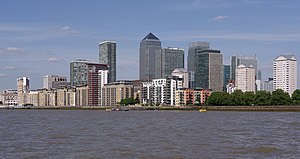Canary Wharf
London's Canary Wharf district is a neighbourhood that underwent a redevelopment in the late 20th century, that saw real estate prices skyrocket.[1] London developed as a river port. There is a bend in the Thames River, opposite the neighbourhood of Greenwich, which became an industrial area, with many wharves and warehouses, that had grown obsolete by the late 20th century, when goods were shipped by standard sized containers.

Canadian real estate developers from the Reichmann family developed a plan to redevelop the neighbourhood, around businesses and expensive residential buildings. Their plan included building a Rapid transit route to the neighbourhood, the Docklands Light Rail, at their own expense.
By 2021 the neighbourhood had 17,000 feet of office space.[2]
References
- ↑ John Willcock, Clare Garner. pounds 2bn float will crown the fall and rise of Canary Wharf, The Independent, 1999-03-02. Retrieved on 2022-04-05. “ONE OF the newest and most instantly recognisable features of London's skyline - Canary Wharf and its fifty-storey tower - is to be floated on the stock market.”
- ↑ John D. Landis (September 2021). Megaprojects for Megaregions: Global Cases and Takeaways. U.S. Department of Transport. Archived from the original on 2021-12-03. Retrieved on 2022-04-05. “With over 17 million square feet of commercial space, forty buildings and more than 120,000 employees as of this writing, Canary Wharf is a prominent example of urban regeneration rising from one of England’s most distressed communities, as well as an illustration of the importance of foresight, patience, and luck—both good and bad—when it comes to developing urban megaprojects.” mirror 2021-12-03
